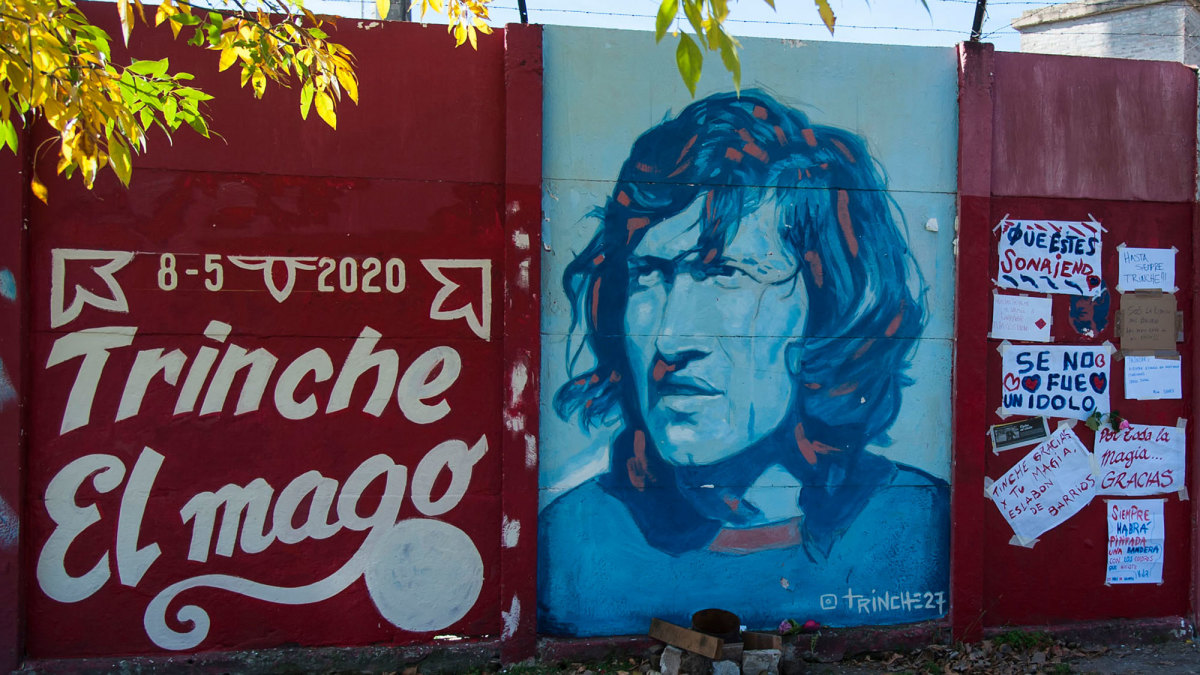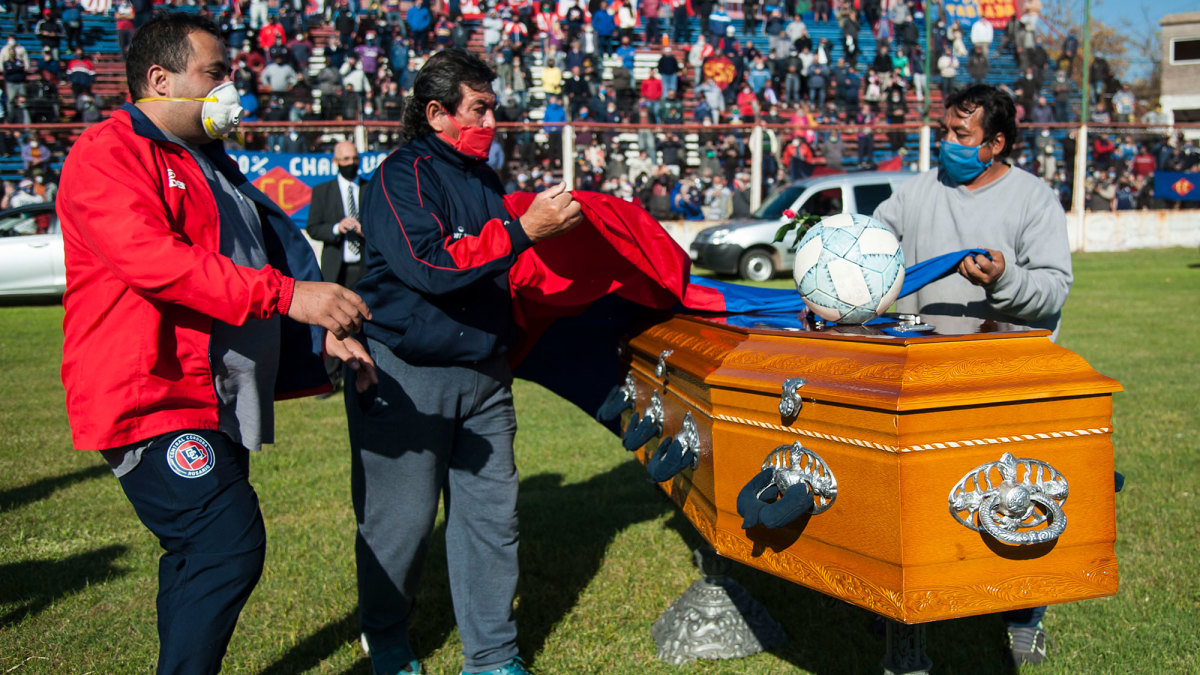The Legend of Argentina's Tomas 'El Trinche' Carlovich: 'More Myth Than Man'
Last Friday, Tomas Felipe Carlovich, El Trinche (the Fork), died. He had been in an induced coma in Rosario, Argentina, since Wednesday, when he was struck on the head by a thief who stole his bicycle. Argentinian football fell into deep mourning, not just for the senseless loss of a popular 73-year-old but for the death of a dream.
Carlovich never won an international cap. He never won a title. He played only two games in the top flight. Hardly any video footage of him as a player exists. He was more myth than man. But he represented an ideal of what Argentinian football believed itself, at its best, to be. He was the only player Diego Maradona ever said was better than him. Jose Pekerman called Carlovich the best midfielder he ever saw. That conventional success seemed of no concern to him was part of his glory.
Born in Rosario, one of seven sons of a Yugoslav immigrant, Carlovich grew up playing football in the streets and it was there that he always believed real football was to be found: “I tell you why I like to play on the streets—a player who goes onto the pitch and looks up into the stands where there are 60,000, 100,000 people, how is he going to enjoy the game? He can’t play, ever. Those people in the stands, their demands, their insults…”
In that, his upbringing perfectly fit the template. From the rapid urbanization of the 1920s, the belief in Argentina had been that the true spirit of their game was to be found in the pibes (kids) who played on the potreros (vacant lots); who learned technique and balance on hard uneven surfaces; who developed skill and streetwiseness to protect the ball and themselves in unruly mass games in small spaces. They were not, the argument ran, like the British, who had introduced football 50 years earlier but had played on vast playing fields under the controlling gaze of a teacher and so developed a game based on running and speed.

Carlovich was tall and slim with a shaggy mane of hair he maintained throughout his life. At 15, he joined Rosario Central where he developed as an elegant if slow midfielder. Carlos Griguol, a notoriously tough coach, gave him his first-team debut at 20. He played two games and was selected for a third, an away game in Buenos Aires. He arrived early for the bus and took a position on the back seat, but after waiting 10 minutes, he got off, went back home and played that afternoon for the amateur club Rio Negro. He never returned to Rosario Central.
“He was a phenomenon of a player,” said Griguol, “but he does not like sacrifice, so he didn’t succeed playing with me at Central and preferred to go hunting or fishing. He had unique technical abilities.”
Why he left was never adequately explained. Was he bored, or was it the pressure of the big crowds? Was it even a profound homesickness that left him unable to contemplate leaving Rosario? Carlovich eventually joined another club in his home city, Central Cordoba, for whom he played a total of 236 games in four separate spells, helping them twice earn promotion from the third division to the second. If he found a home anywhere, it was there.
“Many things have been said about me,” he said, “but the truth is that I never liked being far from my barrio, my parents' house, the bar I used to go, my friends, and ‘El Vasco’ Artola, who taught me how to kick the ball when I was a boy.”
He was so shy he preferred to change in a utility room rather than in the dressing room with his teammates, but fame, unbidden, would arrive anyway. In April 1974, as part of their preparation for the World Cup, the Argentina national side took on a Rosario Select XI, managed by Griguol, in a friendly to raise funds for the Sports Journalists Circle. Carlovich was noted for a particular trick, a double nutmeg, first forwards and then backwards, that he would attempt to perform on demand from the crowd. But surely not against the national side, right?
The ball came to Carlovich. Pancho Sa, who would become the most decorated player in the history of the Copa Libertadores, closed him down. Carlovich nutmegged him. The crowd knew what was coming. Sa didn’t. Carlovich checked back and nutmegged him in reverse. The stadium erupted.
By halftime, a scratch Rosario selection–five from Rosario Central, five from Newell’s Old Boys and Carlovich–who had never played or even trained together before, were up 3–0. Radio commentator Hector Vidana spoke of “the dance of the Rosarinos.” Argentina manager Vladislao Cap reputedly asked for Carlovich to be taken off. He stayed on, and Argentina pulled one back in the second half, but his legend was secure. He was, said Jorge Valdano, “the symbol of a romantic football that practically does not exist anymore.”
In 1976, Carlovich joined Independiente Rivadavia in Mendoza, 500 miles to the west. He hated it. One Saturday he got himself sent off just before halftime so he could catch a bus back to Rosario in time for Mother’s Day. On another occasion, on a hot, sunny day, he and two teammates held the ball for several minutes, passing it to each other in the shade of some trees, until the referee stopped the match and told them to play properly. He loved the game, but he hated discipline. More than anything, he wanted to have fun.
The arch-romantic Cesar Luis Menotti tried to call him up to the national side in 1976. “It was a delight to watch Carlovich play, he had so much ability on the ball,” he told Movistar+. “I picked him for the national team, but he didn't show up. I can't remember if he had gone fishing or was on an island but his excuse was that he couldn't get back because the river level was too high.”
It’s said that Marcelo Bielsa, himself a proud Rosarino, another tall but slow player, tried to model his game on Carlovich, before dropping back into defense. Certainly the haircut he sported in his teens was similar.

Carlovich retired in 1983, came back, and retired again in 1986. He kept playing in games in his barrio, while working as a bricklayer until osteoporosis made both impossible. A benefit evening featuring two exhibition matches was arranged to help pay for treatment. The crowds again sung his name and then a journalist asked if there was anything he would change about his career, anything he would do differently.
“No,” he said, voice wavering. “No, sir, don’t ask me that.” He bit his lower lip. “No, not that.” Then the tears fell from his eyes. Nobody had realized before that he felt regret, that he wondered what he might have been. The spirit of the pibe brings great freedom, but there is a cost.
When Maradona, returning from his first drugs ban, and after an abortive spell at Sevilla, joined Newell’s in 1993, he was greeted as the best player in the world, at which he interrupted.
“The best,” he said, “has already played here.”
Earlier this year, Carlovich and Maradona, by then managing Gimnasia La Plata, finally met.
“He started speaking into my ear and wouldn't stop," a visibly moved Carlovich said. "He even signed a shirt for me and wrote, 'Trinche, you were better than me.' The only thing I could answer was, 'Diego, now I can leave this world in peace, you were the greatest I ever saw in my lifetime.'"
They are words that bear a dreadful freight now that the player of the streets has been killed in the streets. His was a very Argentinian life and also a very Argentinian death, an act of horrific violence ending a beautiful but unsustainable dream.
